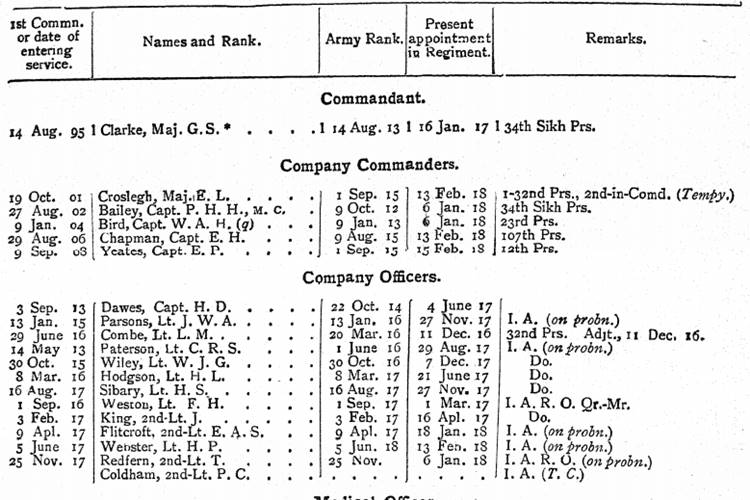This article is about the short-lived 2nd Battalion 34th Sikh Pioneers and will help you to Research the Regiment and those who served with it during the First World War. I have created separate articles for the 1st and 3rd Battalions 34th Sikh Pioneers and a series of guides to help you research soldiers who served in the Indian Army during the war. To view the guides click on the blue links below:
- 1st Battalion 34th Sikh Pioneers
- 3rd Battalion 34th Sikh Pioneers
- Guides to Researching Soldiers who served in the Indian Army
The 2nd Battalion 34th Sikh Pioneers in the First World War
Lineage: The 2nd Battalion 34th Sikh Pioneers was formed at Sialkot (Punjab, Pakistan) on 7 June 1917 and disbanded on 31 January 1921. For a history of the Regiment’s lineage see my page on the 1st Battalion 34th Sikh Pioneers.
Class Composition of Battalion in 1919: 4 Companies of Ramdasia and Mazhbi Sikhs.
The 2nd Battalion 34th Sikh Pioneers was a short-lived Indian pioneer battalion which was formed at Sialkot (Punjab, Pakistan) on 7 June 1917. The Battalion’s first commanding officer was Lieutenant-Colonel Bruce Turnbull who was appointed from the 23rd Sikh Pioneers on 2 July 1917. Below is an extract from the July 1918 Indian Army List showing the British officers serving with the Battalion. Like other war-raised Indian battalions the 2nd Battalion 23rd Sikh Pioneers’ British officers were mainly Indian Army officers on probation (on probn). or from the Indian Army Reserve of Officers (I.A.R.O.).
General remarks: The battalion should be fit for field service in about 5 months. The Commandant, his officers and all ranks have done most excellent work. At present the battalion requires one or two more regular officers of experience. The recruits are physically of a good type, and recruiting is going on steadily. The unit should become a very fine battalion later on. Pioneer training has now begun with the most senior recruits.
Confidential review reports on Indian Army units, depots, British officers, etc. for 1917-1918: IOR/L/MIL/7/17029
The 2nd Battalion 34th Sikh Pioneers was mobilised on the 5 May 1919 at Sialkot the day before the Third Anglo-Afghan War broke out. The Battalion spent the war at Jamrud, Landi Kotal and Landi Khana as Corps troops. There is a war diary covering the period between May and September 1919 and I have transcribed a few entries below. The Battalion would serve on the North West Frontier into 1920 with its Depot based at Sialkot. The 2nd Battalion 34th Sikh Pioneers was disbanded on 31 January 1921.
War Diary of the 2nd Battalion 34th Sikh Pioneers
There is only a single war diary for the Battalion which hasn’t been digitized and can only be viewed at the National Archives. I have a copy of the war diary and have transcribed some entries below.
- Date: 05 May – September 1919
- Corps Troops, North West Frontier Force
- Reference: WO 95/5390
- Notes: A good war diary which lists the British officers who departed with the 2nd Battalion 34th Sikh Pioneers for Jamrud on 9 May 1919. Also stated the number of casualties each month, wounded, evacuated etc. There is a sketch map of a section of road between Landi Kotal and Loe Dakka which the Battalion worked on with notes.
Further Sources for the 2nd Battalion 34th Sikh Pioneers
The confidential reports of the Battalion are held at the British Library: Confidential Reports on Regiments etc. IOR/L/MIL/7/17007-17037. These confidential reports also contain the annual reports of the British officers serving with the Battalion. For information concerning British and Indian officers who served with the 2nd Battalion 34th Sikh Pioneers the Indian Army List can be consulted.
Extracts from War Diaries of the 2nd Battalion 34th Sikh Pioneers
05 May – September 1919, North West Frontier Force, WO 95/5390
05 May 1919 – Sialkot – Mobilization orders were received by the Battalion at 09.00 hours on 5 May 1919. All leave and furlough details and detachments which, owing to the disturbances in the Punjab, had been taken for duty at Wazirabad, Hafizabad, Sangla Hill and Jhang Maghiana, were immediately recalled.
11 – 13 May 1919 – Jamrud – The Battalion was on works in connection with making platforms for rail heads at Jamrud. The following casualties occurred during the Battalion’s stay at Jamrud. Jemadar Teja Singh returned to depot. 1 Indian other rank returned to depot. 5 Indian other ranks evacuated to Indian Station Hospital Peshawar.
14 May 1919 – Jamrud – At 08.15 hours on 14 May 1919 the Battalion… moved out in column for Landi Kotal…. The entire march of the column was without any incident, except for some sharp sniping between Sultan Tara and Ali Masjid, which caused the following casualties [6 sepoys listed]. Apart from the above casualties, it is noteworthy that not a single man of the Battalion fell out during the march from Jamrud to Landi Kotal, a distance of 21 miles under an uncompromising sun. The column arrived at Landi Kotal at 18.20 hours the same day and on arrival the Battalion was placed under the orders of the 1 Division.
15 – 17 May 1919 – Landi Kotal – The Battalion was employed improving the cart and motor road between Landi Kotal and Landi Khana. At 19.45 hours on 16 May 1919, the detachment of the 2nd Battalion 32nd Sikh Pioneers, who were left at Jamrud to be equipped with H.V. Rifles arrived. The officer commanding detachment reported on arrival that the detachment had been sniped at 2 miles this side of Ali Masjid and had had the following casualties. No. 2347 Sepoy Bir Singh – severely wounded,
